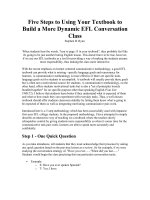3 Steps to Help Your Managers Prepare for Difficult Conversations potx
Bạn đang xem bản rút gọn của tài liệu. Xem và tải ngay bản đầy đủ của tài liệu tại đây (318.17 KB, 2 trang )
3 Steps to Help Your Managers Prepare for Difficult Conversations
During times of budget challenges and
uncertainty, supervisors might be
experiencing an increase in the
number of difficult conversations
with their staff. These could include
delivering bad news about an
employee’s job, informing staff about
work restructuring, or discussing other
complicated and stressful work
situations.
1. Preparing for the
conversation
• Before going into the conversation, ask yourself several key questions. Consult with Human
Resources, peers, and other appropriate resources to be sure you’re comfortable with the
answers.
• Key questions include:
‐ What is my purpose for having the conversation?
‐ What do I hope to accomplish?
‐ What is the ideal outcome?
‐ What assumptions am I making about the other person’s reaction to the conversation?
‐ What “hot buttons” exist – for me and for the other person?
‐ How is my attitude toward the conversation contributing to the intended outcome?
• Practice the conversation. You can mentally rehearse it in your mind, or practice it out loud
with your supervisor, Employee Assistance Program, or Human Resources.
2. Holding the conversation
• A successful outcome will depend on two things: what you say and how you say it. How you
approach the conversation and how you behave will greatly influence what you say and how it is
perceived.
• Acknowledge any emotional energy that might be fueled by the conversation. The emotional
content is as important as the facts.
• Keep aligned with the purpose of your conversation. Don’t be distracted by side tracks.
• Suggestions for opening the conversation include:
‐ I’d like to talk to you about. . .
‐ I want to better understand your point of view. Can we talk more about. . .
‐ I’d like to talk about ________. I think we may have different ideas on how to ______.
3. Working Toward a Successful Outcome
• Approach the conversation with an attitude of inquiry and discovery. Set aside assumptions and
try to learn as much as possible about the other person’s point of view. Let the employees
complete what they have to say without interruption.
• Acknowledge that you’ve heard what the other person is trying to say. The best way to do this
is to repeat their argument back to them. You don’t have to agree. Saying “it sounds like this
issue is very important to you” doesn’t mean that you have to decide the way they’d like you to.
• Advocate for your position without diminishing theirs. State your position concisely and clarify
points they may not have understood.
• End with problem solving. Find mutual areas where you can agree on solutions and identify
what steps need to be taken. If there is no common ground, return to inquiry.
Source : Profiles International
Tags: Workplace Management, Team Management, Leadership Skill Improvement,
Communication Skill
Visit or for more
details









